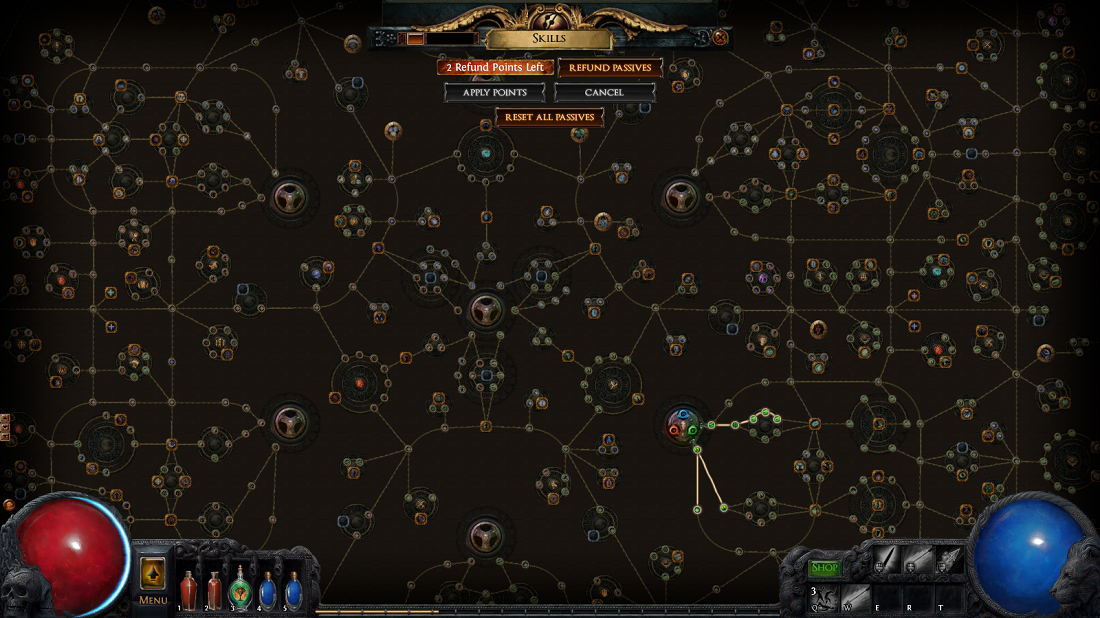Path of Exile
It’s possible to imagine the three big action-RPGs existing on a linear scale, descending from Diablo II. In the middle is Torchlight II, a direct and balanced attempt to build off the classic. On one side is Diablo III, focused on moment-to-moment gameplay and smooth, high-quality player experience above all else. On the other side, then, is Path of Exile, an independently produced free-to-play action-RPG that’s built around customization and mastery.
Path of Exile’s great appeal can be seen in a single image: one of its skill trees. This massive construct looks a lot like Final Fantasy X’s Sphere Grid, but unlike that game, Path offers legitimate choices from the beginning. Starting as a Witch (the mage class), the first few levels involve adding to the Intelligence attribute or building up energy shields. But a few levels later, new areas open, like increasing Dexterity and Strength, giving the opportunity to build any class in any particular direction.
Skills improve in a similarly open fashion: Each skill is tied to a gem, which can be found or traded for throughout the game. Every equippable item can have colored slots that the gems fit into, so you want to be looking for gem and item combos that will work. (The gems can also pair with one another, calling to mind another Final Fantasy, VII and its Materia system.) While the quest reward gems align with class early on—magic for mage classes, melee for fighters, etc.; spending a little more time acquiring gems gives you a much wider variety to build a unique character with.
But Path of Exile’s customization options inherently lead to the issue that the game can be unfriendly to newcomers. It’s not immediately clear which skills and attributes are most important, and this could lead to some failed character builds. This unfriendliness extends to other aspects of the game; for example, the inventory in Path of Exile holds maybe 10 equippable items—somewhat similar to the original Diablo—while its competitors offer significantly more convenient inventory management. But convenience simply isn’t a goal of Path like it is Diablo III—they’re ideologically opposed.
It’s fortunate that Path of Exile offers so much in terms of meta-game customization, because it definitely lags behind its competitors on technical. It looks and feels clunky compared to other action-RPGs. For example, a constant attack spell in Path of Exile like Lightning Tendrils works like this: You press the attack button, and the character casts the spell for a couple seconds in the direction you’re pointing. If you hold down the attack button, the spell repeats. If you move the mouse so the attack changes, the spell casts again at the new angle when it completes after the old. In Diablo III or Torchlight II, casting a repeating spell like that allows constant pivoting—moving the mouse around your character in a circle while holding the button down makes your character turn in that circle, attacking all around. This doesn’t mean that Path is unplayable, but it’s much more focused on the “RPG” part of the genre than the “action”
Path of Exile does have one of the best story/theme connections of the main three action-RPGs. In it, you play a criminal exiled to violent continent and help its developing communities learn about the land and create safe havens. This manifests in interesting ways outside the story, like a lack of direct in-game money. Instead, you sell and buy via barter, using things like Identify Scrolls or gems that buff armor. (Out-of-game money is spent on cosmetic effects, with no pay-to-win.)
Path of Exile has several clever systems like this, but it can be difficult to switch to after the crisp combat feel of Diablo or Torchlight. Picking Path of Exile becomes very much about prioritizing full customization and free-to-play options.
With the big three down, there are also several other relatively recent action-RPGs out there. …



